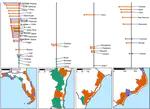Urban Change & Its Impacts

It is notoriously hard to measure and track ‘urban’ as there are multiple dimensions to it; social, demographic, geographic, perceputal, environmental and patterns of growth and decline. In this long standing research project, we seek to provide some novel ways of understanding our urban environments operate and change, and how those changes shape our behaviours. In doing so, we seek to understand the limitations as well as the suitability of measurements from various types of data streams (administrative to environmental sensors). By tracking the changes in these measurements, we seek characterise urban change around the world.
For example, in McCarty & Kaza(2015) we used data from different air pollution sensors in a county to calculate the number of days with bad air quality in a year. We then relate it to urban fragmentation metrics obtained from land cover data. We find that while counties with higher forest land area have higher number of polluted days. This effect is mitigated when these forests are closer to urban areas. Similarly, urban form measured as land use density or type or measured as geomorphometry have been shown to have different on energy consumption patterns in cities.
At the same time, urban economy is also rapidly changing. One narrative of the cities argues for understanding and applauding the renaissance of cities during the decades of 1990s and 2000s (comeback cities). Another narrative suggest that this renaissance is highly uneven and is concentrated in innovative regions, while cities in the rest of the regions (backwards) are loosing ground. To provide evidence for explanations and to disentangle the causes of these phenomena are some of the main motivations of this project.
A natural outgrowth of this research is produce different plausible futures of urban form in different places. Since the configuration as well as the extent of urban form matter for climate as well as environmental outcomes, we seek to develop methods for projecting different futures based on various patterns, we observe in the past and learn from them.
Our goal is to expand the repertoire of urban areas to include areas from various parts of the world, including Asia, Africa and South America.





